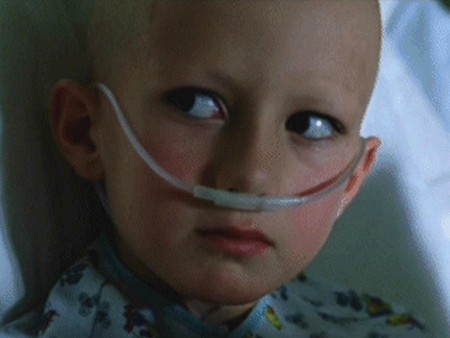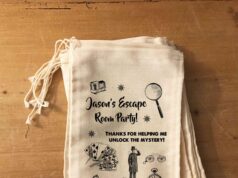Everyone has heard of a little thing called the ‘Placebo Effect’. If you haven’t, it’s a psychological process whereby the act of simply doing something (or eating something) that you’ve been told has a beneficial effect (health, taste, etc) tricks your brain into feeling that effect. It’s something unscrupulous salespeople have been taking advantage of for years with things called ‘snake oil’ scams. It’s been thought these types of scams died out a while ago, but it appears they didn’t. Their PR department only got better…
6.
Fighting Terror With Voodoo
In this post-9/11 world (we get a journalism hard-on just writing that) it is impossible to get on a plane without wondering if the suspicious dude in seat 4B is carrying a bomb. Terrorists can store explosives in toothpaste rolls, water bottles and even shoes! Hundreds of lives are at stake, which instantly precludes any rational thinking on the subject.

Booga-boo!
In late 2009, the TSA ordered $165 million worth of full body scanners, and Amsterdam’s Schiphol Airport just activated 17 new scanners to monitor flights leaving for the US. That’s a ton of money, but we guess no price is too high for the safety of our nation’s tourists and drug smugglers. Except those scanners don’t work, at least well enough to justify the price tag.
“I don’t know why everybody is running to buy these expensive and useless machines. I can overcome the body scanners with enough explosives to bring down a Boeing 747,”
That’s what Rafi Sela, former chief security officer for the Israel Airport Authority, had to say about the full-body scanners the Canadians paid a quarter-of-a-million a pop for. He should know; Mr. Sela helped design the security for Israel’s Ben Gurion International Airport. Something tells us Israel has a little more experience dealing with terrorism than Canada.

Then again…
It’s worth noting that these full-body scanners would have done nothing to detect the failed 2006 liquid bomb plot or the 2005 London train bombing. They couldn’t have stopped the underwear bomber, and the machines can’t even detect objects stuffed inside the body. For a moment there, we were worried we’d have to get creative with our coke smuggling.
Fooling the TSA and Canada is one thing, but conning the entire Iraqi army is another. A UK-based company named ATSC has made eighty-five million dollars selling the ADE-651 bomb detector to Iraqi security forces. This wonder-gadget is capable of detecting everything from TNT to elephant ivory. It allows security forces with minimal training to scan whole cars in a manner of seconds, which gives them additional time to devote to being ridiculously corrupt.
The only problem with the ADE-651 is that it is basically an empty box, powered by magic. This space-age detector doesn’t even have a battery. Instead, soldiers are expected to walk in place for “a few minutes” to charge it. The US Army has stated openly that the devices do not work, but Iraqi Major-General Jedad al-Jabri swears by his voodoo-sticks
5.
Facial Recognition Technology
What were you doing when the towers fell on 9/11? Most Americans over the age of 12 or so have an answer to that question. In the case of Joseph Atick, founder and former C.E.O. of a company named Visionics, the answer was almost certainly “masturbating”.

Tell us that isn’t the most unsettling thing you’ve pictured today
While the rest of the American economy was busy furiously shitting itself, Visionics saw its stock price triple just a week after 9/11. Joe Atick took the nation’s greatest tragedy in recent memory and used it as a platform to sell his own special brand of snake oil. He sent a mass email out to the press that afternoon.
Visionics specialized in facial recognition technology, or FRT, which works by analyzing images taken by security cameras to find and reveal terrorists before they can strike. A computer program looks at the security footage, measures some of the nodal points on your face, and then compares it to a database of known terrorists.
FRT systems from Visionics and other companies quickly spread to at least two major (Tampa, Florida counts as major, right?) American cities, as well as potential Terrorist Targets like Ellis Island and D/FW Airport. Great! So we’re safe, right?
Well, maybe not. It turns out there are serious problems with facial recognition technology. And when we say “serious problems” we really mean “it barely works at all”.
A government study found a 43% rate of false-negatives for subjects aged just 18 months from their pictures. That means FST systems fuck up almost half the time under ideal circumstances. The same study found that changing the camera angle just 45 degrees rendered the software completely useless. The ACLU took a look at police data from the city of Tampa and found that not a single suspect from the database had yet been identified, although there were tons of false positives.

We’re 68% sure the kid on the right is bin Laden
So the fancy facial recognition technology that nations around the world have spent millions and millions of dollars on only works under tightly controlled circumstances, and even then it doesn’t work very well. Oh, and also it sometimes it might accidentally tell the police that you are Muhammed bin Dickwad and send a van full of FBI agents after you. But hey, at least we’re safe from every terrorist with a crystal-clear picture on file.
4.
Snake Oil and the Justice System
Can you imagine what the invention of a perfect lie detector would do to society? No more faking sick to go out and party, no convincing the officer you were burning incense, and no preaching against gay marriage while fucking male prostitutes in exchange for crystal meth.
Some people think this brave new world is just on the horizon. Recent studies indicate that fMRI brain scans may be the future of lie detection. India just convicted a woman of murder based on the results of an MRI lie test. No Lie MRI, a California-based company, is pushing to make the technology standard judicial procedure here in the US.

Finally, a futuristic crime-fighting option that doesn’t involve Tom Cruise
fMRI stands for functional magnetic resonance imaging. Basically, it is a giant machine made of magnets that maps your brain by measuring the flow of oxygenated blood. The bits of your brain that are being used most heavily will have the most blood. If you can isolate what lying does to the brain, you just have to scan for that. So there you have it; science has invented the perfect lie detector.

A few decades earlier would have been great but hey, whatever
Unfortunately, there is almost no evidence that fMRI technology can detect lies in any meaningful way. There are only around a dozen peer-reviewed studies of the techniques used by companies like No Lie, and none of them involve very large sample groups.
All lying is not created equal. Subjects in the fMRI studies were given envelopes with $20 bills and playing cards in them and told to lie about identity of the card in order to keep the money. You wouldn’t approve a cancer treatment based on tests involving a few dozen healthy people. Why assume the brain of a middle-class college student being ordered to lie in order to win money would act the same as the brain of a serial killer with well-rehearsed story and his freedom on the line?
Daniel Langleben is a psychiatrist whose research is the backbone of No Lie’s techniques. He is the scientist who conducted the best-known study on fMRI lie detection.

People start to lose their ability to think rationally as soon as you surround them with fancy technology. That’s why Apple Stores make money hand over fist, and its why people are lining up to believe in the infallibility of fMRI lie detectors. Polygraph machines aren’t very impressive to look at, but an fMRI gives you sexy color scans of a person’s brain.
In fact, a graduate student at Yale recently published a study which showed that inserting the words “brain scans indicate” into a ridiculous explanation for some psychological phenomena made it more believable to the average layman. In doing so, he proved something Star Trek screenwriters have known for years; the difference between science and magic is mostly semantic.
3.
Sunscreen
In 1918 the Bailey Radium Laboratories launched Radithor, a product made from triple-distilled water infused with the radium 226 and 228 isotopes. Radithor was hailed as a cure-all by its users until they all mysteriously died of radiation poisoning.

Don’t worry guys- it’s certified!
Thankfully, Radithor is a relic of the last century. Quack snake oil peddlers may have gotten away with some ridiculous things when our grandparents were in diapers, but people today are much more discerning. At least until someone in a lab coat says the word “cancer”.

BOOGA-BOO!
8,650 people in the United States died of melanoma, the deadliest type of skin cancer, in 2009. Summertime PSAs and middle school health teachers lead us to believe that we could avoid the same grisly fate by slathering on enough high SPF sunscreen to make us look like a Bukkake film extra.
While it’s true that tanning is about as retarded as drinking radium, the idea that sunscreen will protect you from skin cancer needs revision. A study released in May 2010 showed that 92% of sunscreen lotions on the market are completely ineffective.
One common sunscreen additive, retinyl palmitate, has been found by the FDA to speed up skin lesions and act as a photocarcinogenic. Oxybenzone- a chemical you’ll find in Coppertone and a ton of other big-name sunblocks, has been linked to contact eczema and breast cancer. But hey, at least you’ll be safe from melanoma!

Yay?
Unless you aren’t. If you listened in health class, you know to look for a sunscreen with an SPF above 30. Unfortunately, SPF only measures the sunscreen’s ability to block UVB radiation. UVA radiation causes skin cancer but doesn’t leave sunburns, and most major sunscreens don’t block it.
And it gets worse. The FDA has yet to create any regulations for how sunscreens are allowed to indicate their UVA protection. As a result, tons of sunscreen manufacturers have started marketing their products as having “broadspectrum” protection. This would seem to indicate that the sunscreen protects you against both types of ray, but it is actually a completely meaningless marketing term. Until the FDA gets off their ass and sets a standard, you have no real way to know if your skin is protected.

The best protection your skin can get
2.
Drowning Big Brother in Data
HOLYFUCKPANIC! The CIA is monitoring the Internet and your credit cards. They have a record of every purchase you ever make. The NSA records every Google Chat session and the Treasury Department randomly combs your garbage for shredded documents. Big Brother is out to fuck your face and not even the strongest bear mace will hold back his advances.

Dick Cheney, moments before running down a pregnant gazelle and biting through her jugular
There’s no shame in being freaked out about the government gathering data on you. The Department of Homeland Security actually buys consumer history reports from third party collection firms so they can know who to screen at borders. Constant Internet access and the viral growth of social media has put more information about you into the public sphere than ever before possible. You might as well be standing naked in front of a picture window.

Discretion is the better part of boredom
Of course, when everyone in the damn country stands naked in front of their picture windows it sort of loses its impact. One naked person is an oddity, but 400,000,000 naked people is just a bland sea of obesity and track-marks. While privacy advocates abhor the idea of mass data mining, the truth of the matter is that there is anonymity in a crowd.
In 2008, the Department of Homeland Security and the National Science Foundation released a massive report about the effectiveness of the government’s data-mining techniques. The title says a lot; “All Counterterrorism Programs That Collect and Mine Data Should Be Evaluated for Effectiveness, Privacy Impacts; Congress Should Consider New Privacy Safeguards.”
Having all the data in the world can’t help you to draw accurate conclusions on it. Data-mining programs have a huge rate of false positives, which wastes millions in law enforcement dollars and makes it more difficult to pin down real threats.
The interconnected nature of the modern world means that you can draw a line between pretty much any two people on earth, if you torture the data right. The NSA’s entire spying program is based around the idea that terrorists can be revealed by their communications patterns. If you spend a lot of time talking to dangerous middle-eastern men about guns and bombs, you’re probably a terrorist. But you could just as easily be Donald Rumsfeld.

The 9/11 Commission concluded that ample evidence of the attacks existed ahead of time. In Cory Doctorow’s words, “…the American intelligence community knew in advance that the attacks on the World Trade Center and Pentagon were in the offing, they just didn’t know they knew it.”
Data-mining works well for credit card companies trying to detect fraud, but terrorist attacks are more complicated. Mining vast reams of purchase data to try and pick out the next McVey is like looking for a needle in a haystack that may not actually have a needle in it. Right after 9/11, the NSA investigated thousands of tips. Virtually all of them lead to “dead ends or innocent Americans.”
Government agencies continue to expand their data-mining efforts every day. All this raw info keeps Big Brother too busy tracking down bullshit leads to notice which sex toys or rare hallucinogens from Canadian labs you buy. Your privacy is safe but, thanks to data-mining, you may not be.
1.
A Ton of Actual Medicines
Every person’s body is different. An obese 40-year-old women will be less affected by pain meds than an emaciated 20-year-old basement-dwelling nerd. Your lifestyle, dietary and drug habits all change how you will react to drugs. Doling out prescriptions is a science of trial and error.

Diddy mao, doc!
No medication is going to work on everyone 100% of the time, but some of them don’t work at all. A 2008 study in the New England Journal of Medicine showed that the popular diabetes drug Starlix was only “marginally” effective in slowing the development of type II diabetes. A popular high blood pressure medication, Diovan, was found to have no effect on your odds of developing heart problems.

Take 500 mgs of snake oil and call us in the morning
While Diovan and Starlix may not make you healthier, at least your kids can’t get high off of them. A 2009 study in the UK by the Medicines and Healthcare Products Regulatory Agency showed that products like Day Nurse and Sudafed had “no robust evidence” of working on children.
It’s worth noting that over three million Americans between 12 and 25 have used an over-the-counter cough medicine to get fucked up. While many of those cases were probably hippies getting safely stoned in the backs of their Volkswagen vans, even more of them were kids. While that’s hilarious in a South Park episode, actual toddlers are dying from overdoses of this “medicine” with no evidence of effectiveness.
Popular ADHD medications also suffer from the same problem of not working at all. A study on the long-term effects of drugs like Concerta and Ritalin found that they had “no demonstrable benefit for children” in the long term.
ADHD drugs aren’t benign snake-oil either. They can stunt a child’s growth and weight and may impair thinking ability. But hey, at least little Johnny will shut the hell up.

Dumb kids ask less questions
Written by Simon OBrien – Copyrighted © www.weirdworm.net Image Sources Image sources:
- – Fighting Terror With Voodoo: http://www.causes-of-terrorism.net/images/taliban2PT.jpg
- – Facial Recognition Technology: http://www.itl.nist.gov/div893/from-div895/bc/bc2001/atikphotopic.jpg
- – Snake Oil and the Justice System: http://www.othervoices.org/2.3/msharpe/precog.jpg
- – Sunscreen: http://esmeraldasquietlife.files.wordpress.com/2010/04/radithor.jpg
- – Drowning Big Brother in Data: http://scrapetv.com/News/News%20Pages/Health/images-2/dick-cheney-angry.jpg
- – A Ton of Actual Medicines: http://www.casino-article.com/wp-content/uploads/2009/09/Russian-Roulette.jpeg







